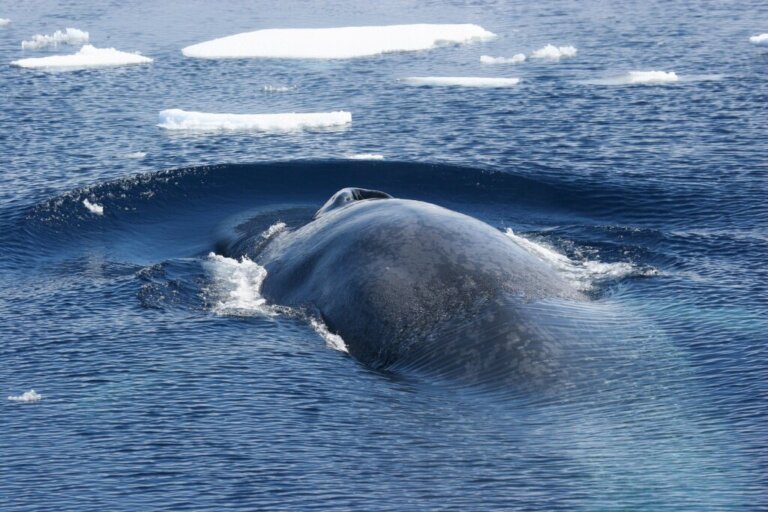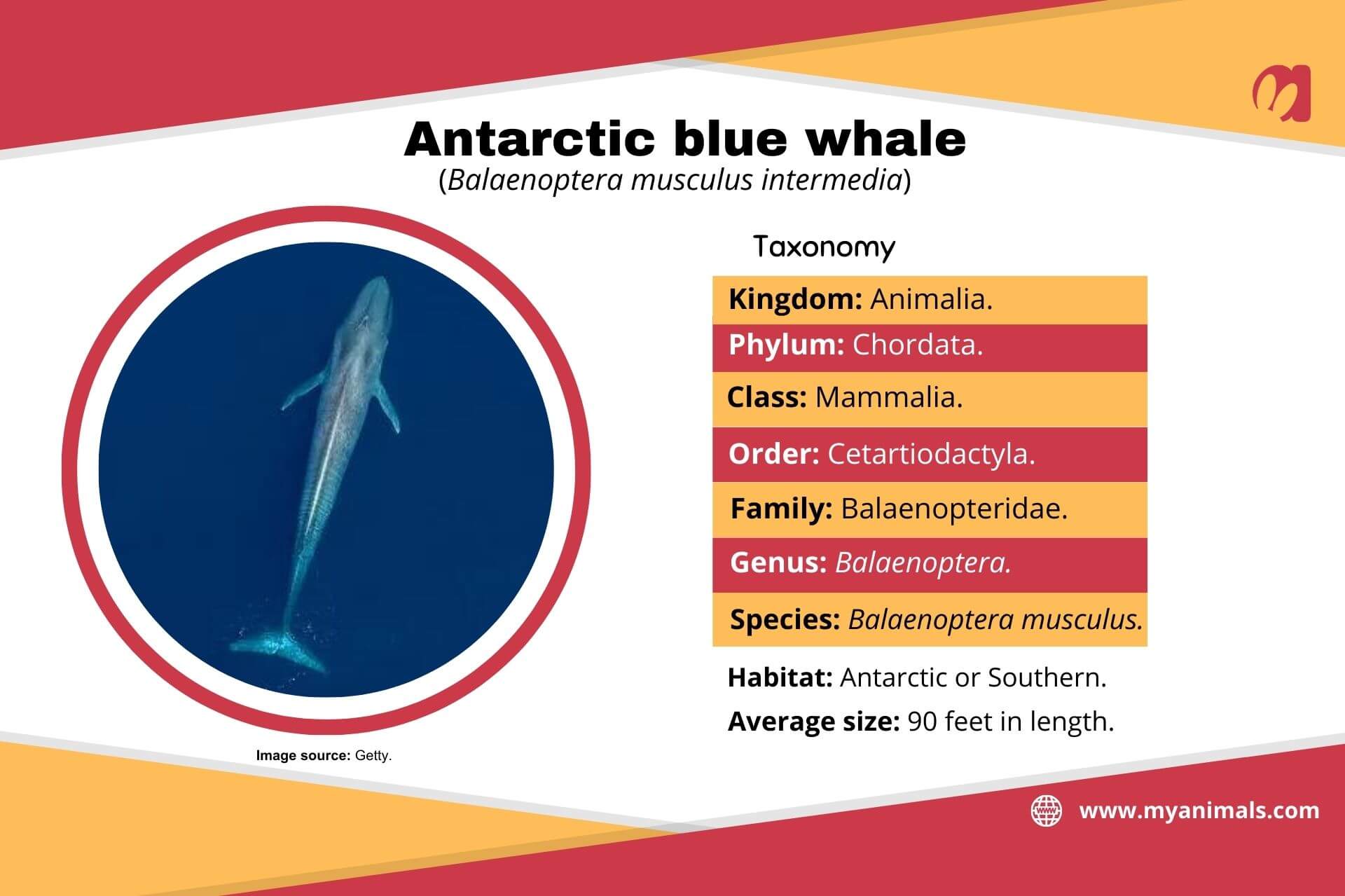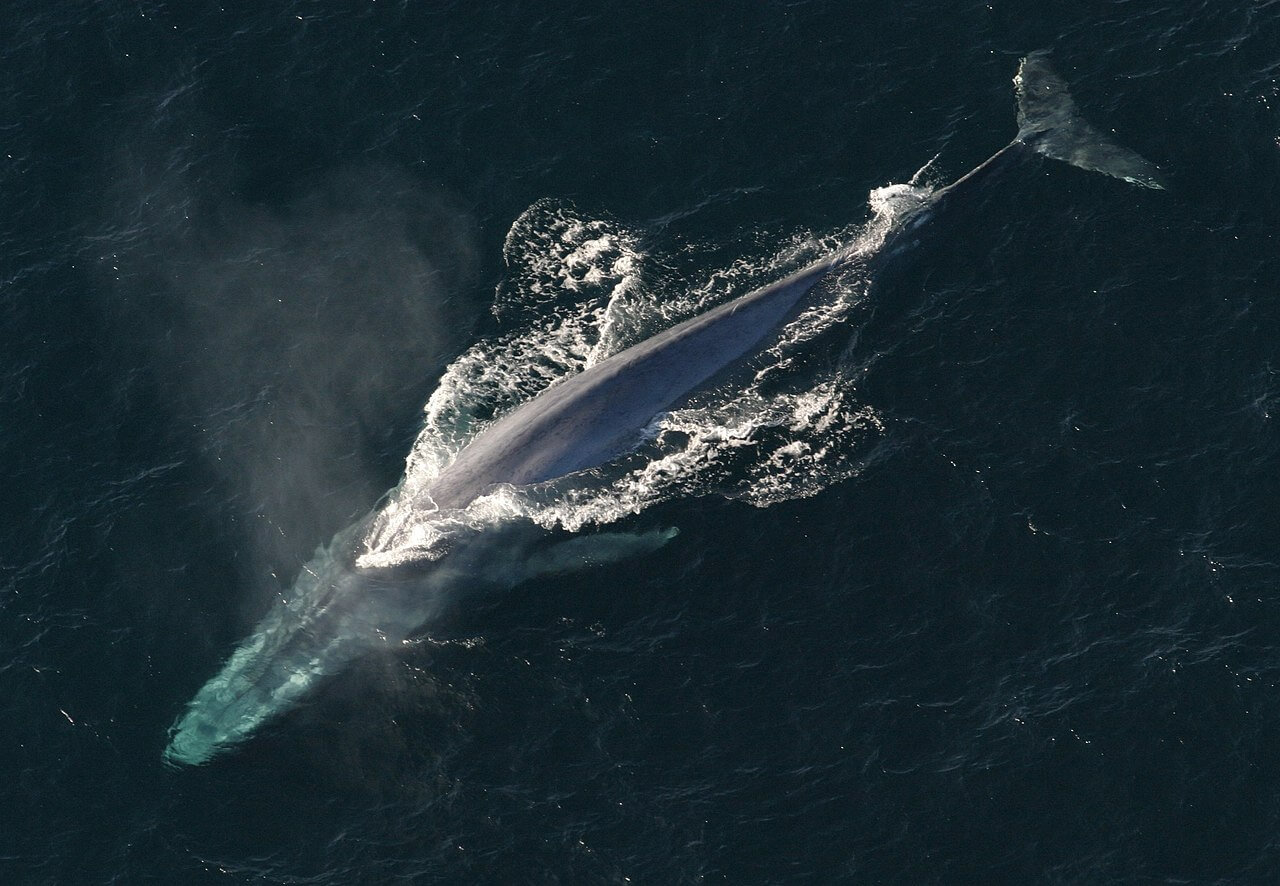5 Fun Facts About the Antarctic Blue Whale


Written and verified by the biologist Georgelin Espinoza Medina
The whale is a creature that’s impeccably adapted to its aquatic habitat, despite being a mammal. Its impressive size and mass make it a standout species, with the blue whale claiming the title of the world’s largest. Would you like to delve into some intriguing facts about the Antarctic blue whale?
Belonging to the Balaenopteridae family, the blue whale’s scientific name is Balaenoptera musculus intermedia, and it’s one of the four subspecies of blue whales. To unveil fascinating aspects of this incredible animal, we’ll present you with five interesting facts that are bound to leave you amazed.
Characteristics of the Antarctic blue whale

Before we explore these curiosities about the Antarctic blue whale, which belongs to the order of cetaceans, let’s familiarize ourselves with some of its characteristics, offering a better understanding of this massive marine mammal.
It boasts an elongated and robust body and a large head. It has a pair of spiracles (blowholes) on top and four fins in total—two pectoral, one dorsal, and one caudal—the latter being notable for its horizontal arrangement (unlike fish).
These marine animals lack teeth and, instead, have baleen plates in their mouth, which help them with their diet, which is based on krill.
As for its coloration, the body of the Antarctic blue whale consists of two shades, a bluish gray on the dorsal or upper part and a lighter, white color for the ventral or lower area. Notably, it possesses thick skin that’s equipped with sufficient fat to regulate body temperature and store energy.
Curious facts about the Antarctic blue whale
Now that we know a little about these specimens, let’s see the following list with five curious facts about the Antarctic blue whale.
1. The Antarctic blue whale is the largest mammal
The Antarctic blue whale holds the title of the largest mammal on the planet, reaching lengths of up to 88.5 meters between its head and its body, according to figures reported by the Animal Diversity Web.
According to the Encyclopedia of Marine Mammals, the largest females were observed in Shetland and South Georgia, measuring 104 to 107 meters in length. This maximum dimension is equivalent to 6.4 Ford Explorers or 6.45 hippos (each measuring up to 16 feet), something truly astounding.
2. It’s the heaviest animal on the planet

In addition to its impressive size, the Antarctic blue whale is also, as expected, the animal with the largest body mass in existence. It usually reaches 150 tons.
The Encyclopedia of Marine Mammals also notes a South Georgian female weighing 190 tons in 1947.
This weight corresponds to that of 31.14 African elephants (Loxodonta africana). Compared to the largest ever known – which reached a weight of 6.7 tons – it’s still a very light specimen compared to a blue whale.
3. The blue whale calf is also large
Just as adults have impressive sizes, calves are no exception. When they first emerge from their mothers’ bodies, they can already measure 26 feet. This is equivalent to the size of a medium-sized bus. In addition, they’re 16 times larger than a 19.7-inch human baby at birth.
Baby whales weigh around 6000 pounds.
Antarctic blue whale calves can consume up to 379 liters of milk per day during the lactation period, which lasts about 7 to 8 months. During this period, they reach some 20,900 kilograms of body mass. This is according to data from The MarineBio Conservation Society.
4. Possesses the largest heart in the entire animal kingdom
Another curious fact about the Antarctic blue whale is the impressive weight of its heart. Of course, this is to be expected once you know the measurements and total mass of this species. However, discovering that the animal’s heart weighs 1,323 pounds is still jaw-dropping, especially if we compare it with our own, which barely weighs 1.5 ounces, or that of an elephant, which weighs 53 pounds.
Other values related to the circulatory system, such as blood volume, are also significant. The blue whale has 8,260 liters of blood in its body, compared to 5 in humans or 310 in elephants.
5. It’s in “critical danger” of extinction
Despite being the largest animal on the planet, the Antarctic blue whale is in critical danger of extinction. According to reports from the International Union for Conservation of Nature (IUCN), there are currently an estimated 3,000 mature individuals in existence, and the population is increasing (albeit at a very slow pace).
In the past, from 1907 to 1972, this species was the victim of human capture, with a maximum peak during the period from 1931 to 1932 due to the hunting of around 30,000 individuals per year. It’s estimated that B. musculus intermedia was once the most abundant subspecies in the world and has been the most heavily hunted.
Today, blue whales are protected throughout the Antarctic region by entities such as the International Whaling Commission (IWC).
Protection of the largest animal on the planet
Thus, we come to the end of the five curious facts about the Antarctic blue whale, a subspecies of enormous dimensions, considered the largest and most massive animal on the planet. However, this doesn’t make it immune to difficulties, and, in the past, it was a victim of human hunting.
Today, its populations are growing. International bodies are doing their bit to protect these giants of the ocean, who deserve to live in peace, just like all other living beings.
The whale is a creature that’s impeccably adapted to its aquatic habitat, despite being a mammal. Its impressive size and mass make it a standout species, with the blue whale claiming the title of the world’s largest. Would you like to delve into some intriguing facts about the Antarctic blue whale?
Belonging to the Balaenopteridae family, the blue whale’s scientific name is Balaenoptera musculus intermedia, and it’s one of the four subspecies of blue whales. To unveil fascinating aspects of this incredible animal, we’ll present you with five interesting facts that are bound to leave you amazed.
Characteristics of the Antarctic blue whale

Before we explore these curiosities about the Antarctic blue whale, which belongs to the order of cetaceans, let’s familiarize ourselves with some of its characteristics, offering a better understanding of this massive marine mammal.
It boasts an elongated and robust body and a large head. It has a pair of spiracles (blowholes) on top and four fins in total—two pectoral, one dorsal, and one caudal—the latter being notable for its horizontal arrangement (unlike fish).
These marine animals lack teeth and, instead, have baleen plates in their mouth, which help them with their diet, which is based on krill.
As for its coloration, the body of the Antarctic blue whale consists of two shades, a bluish gray on the dorsal or upper part and a lighter, white color for the ventral or lower area. Notably, it possesses thick skin that’s equipped with sufficient fat to regulate body temperature and store energy.
Curious facts about the Antarctic blue whale
Now that we know a little about these specimens, let’s see the following list with five curious facts about the Antarctic blue whale.
1. The Antarctic blue whale is the largest mammal
The Antarctic blue whale holds the title of the largest mammal on the planet, reaching lengths of up to 88.5 meters between its head and its body, according to figures reported by the Animal Diversity Web.
According to the Encyclopedia of Marine Mammals, the largest females were observed in Shetland and South Georgia, measuring 104 to 107 meters in length. This maximum dimension is equivalent to 6.4 Ford Explorers or 6.45 hippos (each measuring up to 16 feet), something truly astounding.
2. It’s the heaviest animal on the planet

In addition to its impressive size, the Antarctic blue whale is also, as expected, the animal with the largest body mass in existence. It usually reaches 150 tons.
The Encyclopedia of Marine Mammals also notes a South Georgian female weighing 190 tons in 1947.
This weight corresponds to that of 31.14 African elephants (Loxodonta africana). Compared to the largest ever known – which reached a weight of 6.7 tons – it’s still a very light specimen compared to a blue whale.
3. The blue whale calf is also large
Just as adults have impressive sizes, calves are no exception. When they first emerge from their mothers’ bodies, they can already measure 26 feet. This is equivalent to the size of a medium-sized bus. In addition, they’re 16 times larger than a 19.7-inch human baby at birth.
Baby whales weigh around 6000 pounds.
Antarctic blue whale calves can consume up to 379 liters of milk per day during the lactation period, which lasts about 7 to 8 months. During this period, they reach some 20,900 kilograms of body mass. This is according to data from The MarineBio Conservation Society.
4. Possesses the largest heart in the entire animal kingdom
Another curious fact about the Antarctic blue whale is the impressive weight of its heart. Of course, this is to be expected once you know the measurements and total mass of this species. However, discovering that the animal’s heart weighs 1,323 pounds is still jaw-dropping, especially if we compare it with our own, which barely weighs 1.5 ounces, or that of an elephant, which weighs 53 pounds.
Other values related to the circulatory system, such as blood volume, are also significant. The blue whale has 8,260 liters of blood in its body, compared to 5 in humans or 310 in elephants.
5. It’s in “critical danger” of extinction
Despite being the largest animal on the planet, the Antarctic blue whale is in critical danger of extinction. According to reports from the International Union for Conservation of Nature (IUCN), there are currently an estimated 3,000 mature individuals in existence, and the population is increasing (albeit at a very slow pace).
In the past, from 1907 to 1972, this species was the victim of human capture, with a maximum peak during the period from 1931 to 1932 due to the hunting of around 30,000 individuals per year. It’s estimated that B. musculus intermedia was once the most abundant subspecies in the world and has been the most heavily hunted.
Today, blue whales are protected throughout the Antarctic region by entities such as the International Whaling Commission (IWC).
Protection of the largest animal on the planet
Thus, we come to the end of the five curious facts about the Antarctic blue whale, a subspecies of enormous dimensions, considered the largest and most massive animal on the planet. However, this doesn’t make it immune to difficulties, and, in the past, it was a victim of human hunting.
Today, its populations are growing. International bodies are doing their bit to protect these giants of the ocean, who deserve to live in peace, just like all other living beings.
All cited sources were thoroughly reviewed by our team to ensure their quality, reliability, currency, and validity. The bibliography of this article was considered reliable and of academic or scientific accuracy.
- Cooke, J.G. (2018). Balaenoptera musculus ssp. intermedia. The IUCN Red List of Threatened Species. Consultado el 10 de junio de 2023. https://www.iucnredlist.org/species/41713/50226962
- Dobson, G. (2003). On being the right size: heart design, mitochondrial efficiency and lifespan potential. Clinical and Experimental Pharmacology and Physiology, 30(8), 590-597. https://onlinelibrary.wiley.com/doi/abs/10.1046/j.1440-1681.2003.03876.x
- Fox, D. (2002). Balaenoptera musculus. Animal Diversity Web. Consultado el 10 de junio de 2023. https://animaldiversity.org/accounts/Balaenoptera_musculus/
- Howard, M. (2017). Loxodonta africana. Animal Diversity Web. Consultado el 10 de junio de 2023. https://animaldiversity.org/accounts/Loxodonta_africana/
- Mason, K. (2013). Hippopotamus amphibious. Animal Diversity Web. Consultado el 10 de junio de 2023. https://animaldiversity.org/accounts/Hippopotamus_amphibius/
- Sears, R., & Perrin, G. (2009). Blue Whale:Balaenoptera musculus. In W. Perrin, B. Wursig, & J. Therissen. (Eds). Encyclopedia of Marine Mammals (pp. 120-124). https://www.sciencedirect.com/science/article/abs/pii/B978012373553900033X
- The MarineBio Conservation Society. (s.f.). Blue whales, Balaenoptera musculus. Consultado el 14 de junio de 2023. https://www.marinebio.org/species/blue-whales/balaenoptera-musculus/
This text is provided for informational purposes only and does not replace consultation with a professional. If in doubt, consult your specialist.








